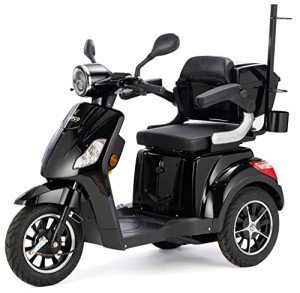A Comprehensive Guide to Buying a Mobility Scooter
Mobility scooters have become a vital tool for many people looking to boost their self-reliance and mobility. With a large selection of designs and functions available, choosing the best mobility scooter can be intimidating. This post provides an informative guide to assist consumers browse their options, assess their requirements, and make a notified purchase.
Understanding Mobility Scooters
Mobility scooters are electric automobiles developed for people who experience mobility obstacles. They are especially beneficial for elders, those with disabilities, or individuals recovering from injuries. click through the up coming website page can vary widely in terms of style, features, and rates.
Kinds Of Mobility Scooters
Before embarking on a purchase, it's necessary to comprehend the various types of mobility scooters available:
Three-Wheel Scooters:
- Generally more maneuverable in tight spaces
- Lightweight and portable
- Suitable for indoor use
Four-Wheel Scooters:
- Offer greater stability and balance
- Ideal for outside use over various surfaces
- Generally have a longer battery life
Foldable/Portable Scooters:
- Designed to be easily carried and saved
- Can typically suit the trunk of an automobile
- Ideal for those who travel regularly
Sturdy Scooters:
- Built to accommodate larger individuals
- Frequently featured more robust features for outdoor usage
- Normally equipped with bigger batteries for prolonged range
Elements to Consider When Buying a Mobility Scooter
1. Weight Capacity
Select a mobility scooter that can support the user's weight. Most scooters have a weight limitation ranging from 250 to 500 pounds. It is important to make sure that the scooter can accommodate the user comfortably.
2. Range and Battery Life
The variety is how far the mobility scooter can travel on a single charge. Typical ranges differ between 10 to 30 miles. Consider the user's everyday activities and pick a scooter with a suitable range.
3. Scooter Dimensions
Consider the size of the scooter, including its weight and dimensions. A more compact scooter might be ideal for narrow corridors and tight spaces, while bigger models provide extra stability and comfort.
4. Terrain Capability
Evaluate where the scooter will mostly be utilized. If the user prepares to travel primarily on pavement, a lightweight model may be sufficient. However, if the user needs to pass through gravel or unequal surfaces, consider a four-wheel scooter constructed for off-road use.
Top Features to Look For
Convenience
- Adjustable Seats: Look for scooters with cushioned and height-adjustable seats to ensure convenience throughout travel.
- Armrests: These enhance security and support while navigating.
Safety and Visibility
- Headlights and Taillights: Essential for nighttime use.
- Turn Signals and Reflectors: Improve visibility and security while on the roadway.
User-Friendly Controls
- Joystick or Drive Controls: These ought to be instinctive and easy to manipulate.
- Easy-to-Read Displays: A control panel that reveals battery life, speed, and range can enhance the user experience.
Extra Features
- Storage Compartments: These use included convenience for bring individual items while on the go.
- Weather Protection: Consider designs with rain covers or windshields if utilized in variable climate condition.
Expense Considerations
When budgeting for a mobility scooter, prices can vary anywhere from ₤ 500 to over ₤ 5,000 depending on the design, features, and brand. Additional costs might include:
- Extended Warranty: Protects against problems and can save cash in the long run.
- Devices: Optional features, such as upgraded seats, lights, or storage services.
| Function | Expense Range |
|---|---|
| Standard Models | ₤ 500 - ₤ 1,500 |
| Mid-Range Models | ₤ 1,500 - ₤ 3,000 |
| High-End Models | ₤ 3,000 - ₤ 5,000 |
Financing Options
Lots of retailers provide funding plans, and some regional federal government efforts may offer grants or assistance for those in need. Examine potential financial support with community resources or mobility service companies.
Frequently asked questions about Buying a Mobility Scooter
What is the difference between a mobility scooter and a wheelchair?
Mobility scooters are motorized and allow users to navigate independently, while wheelchairs may need physical assistance or manual operation.
How do I maintain a mobility scooter?
Regular upkeep includes inspecting battery life, cleaning the scooter, and inspecting tires and brakes. Constantly describe the user handbook for specific standards.
Can mobility scooters be utilized inside your home?
Yes, lots of models are designed for both indoor and outside usage. Nevertheless, three-wheel scooters tend to be better fit for indoor navigation due to their tighter turning radius.
Are mobility scooters covered by insurance?
Some insurance coverage prepares cover a portion of the costs for mobility scooters if they are deemed medically needed. Contact your provider for specific information.
How quickly can a mobility scooter go?
A lot of mobility scooters have an optimal speed varying from 4 to 8 mph. Nevertheless, the proper speed might differ depending upon local regulations.
Getting a mobility scooter can significantly improve one's self-reliance and lifestyle. By comprehending the types, functions, and costs associated with mobility scooters, prospective buyers can make well-informed decisions that suit their requirements and preferences. Personalization and extensive research are key to making sure satisfaction with this important financial investment.

